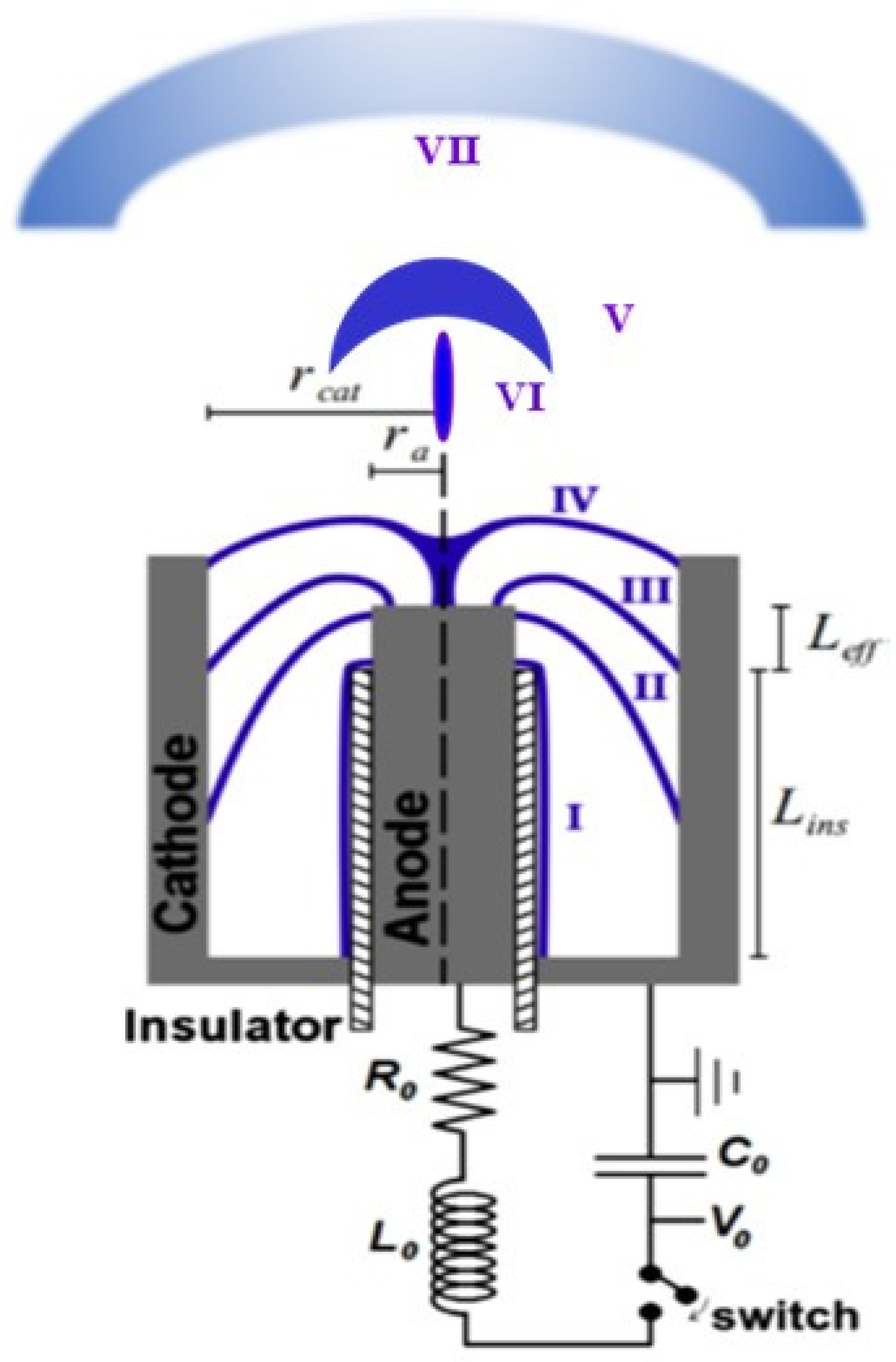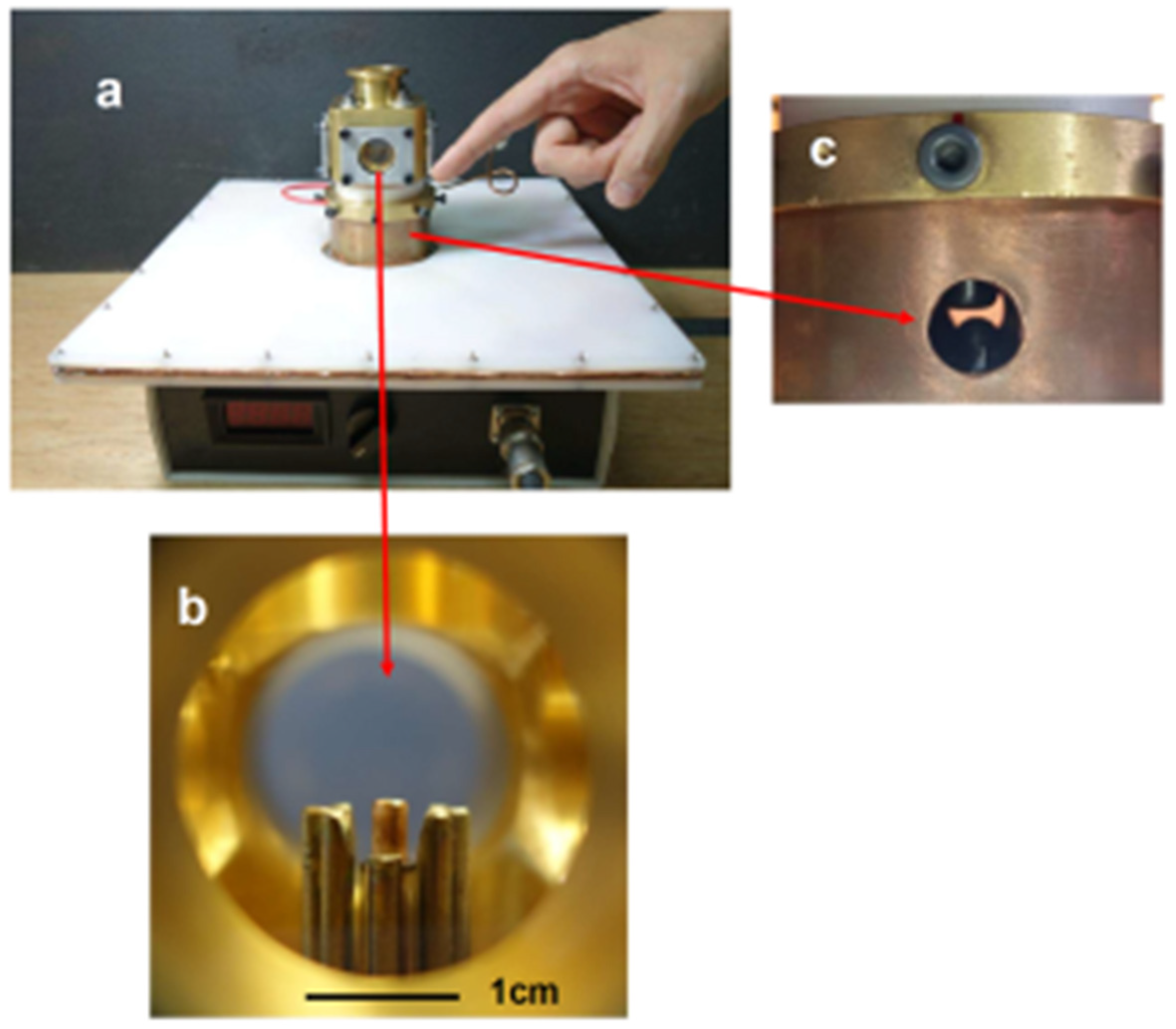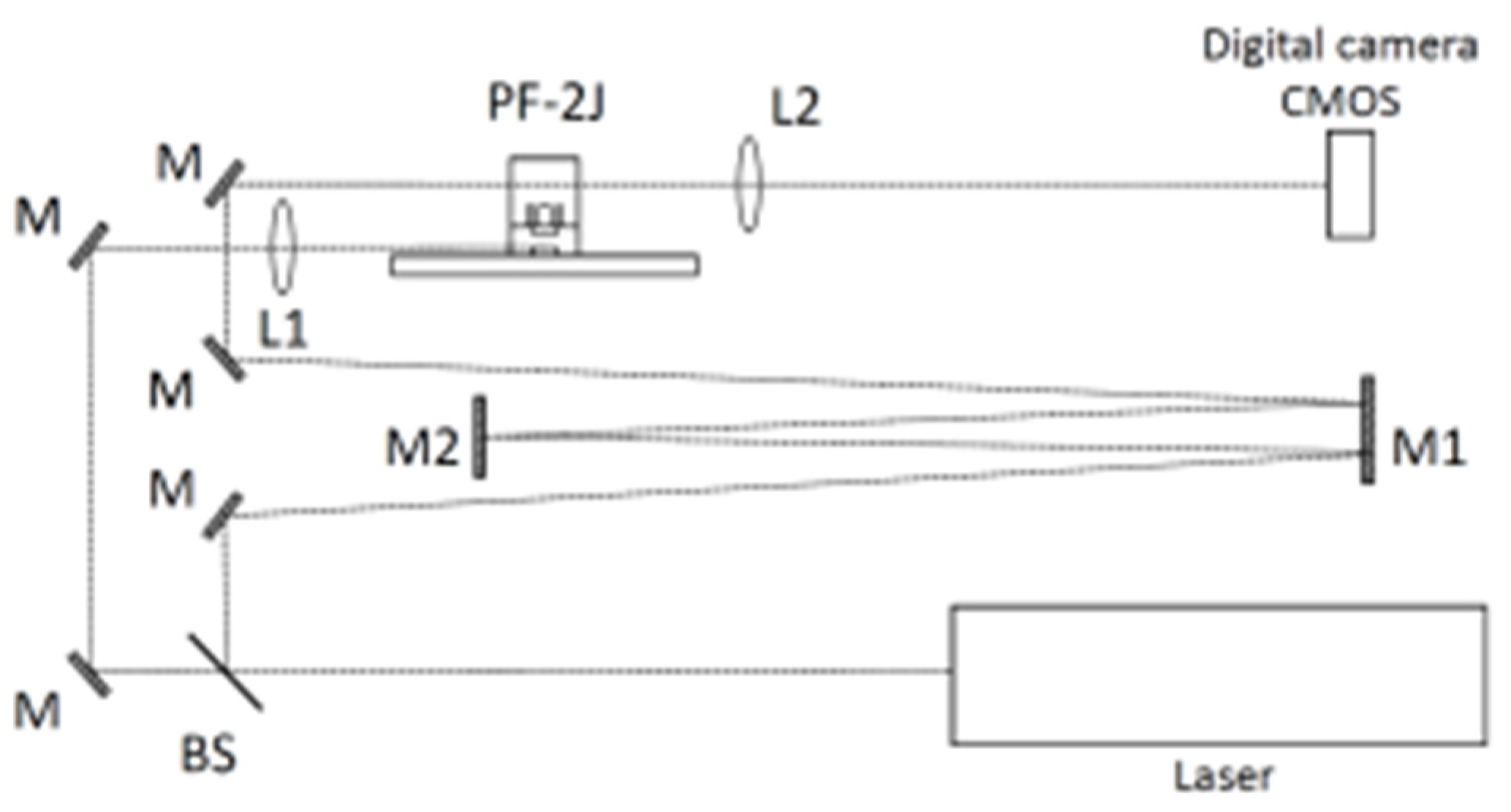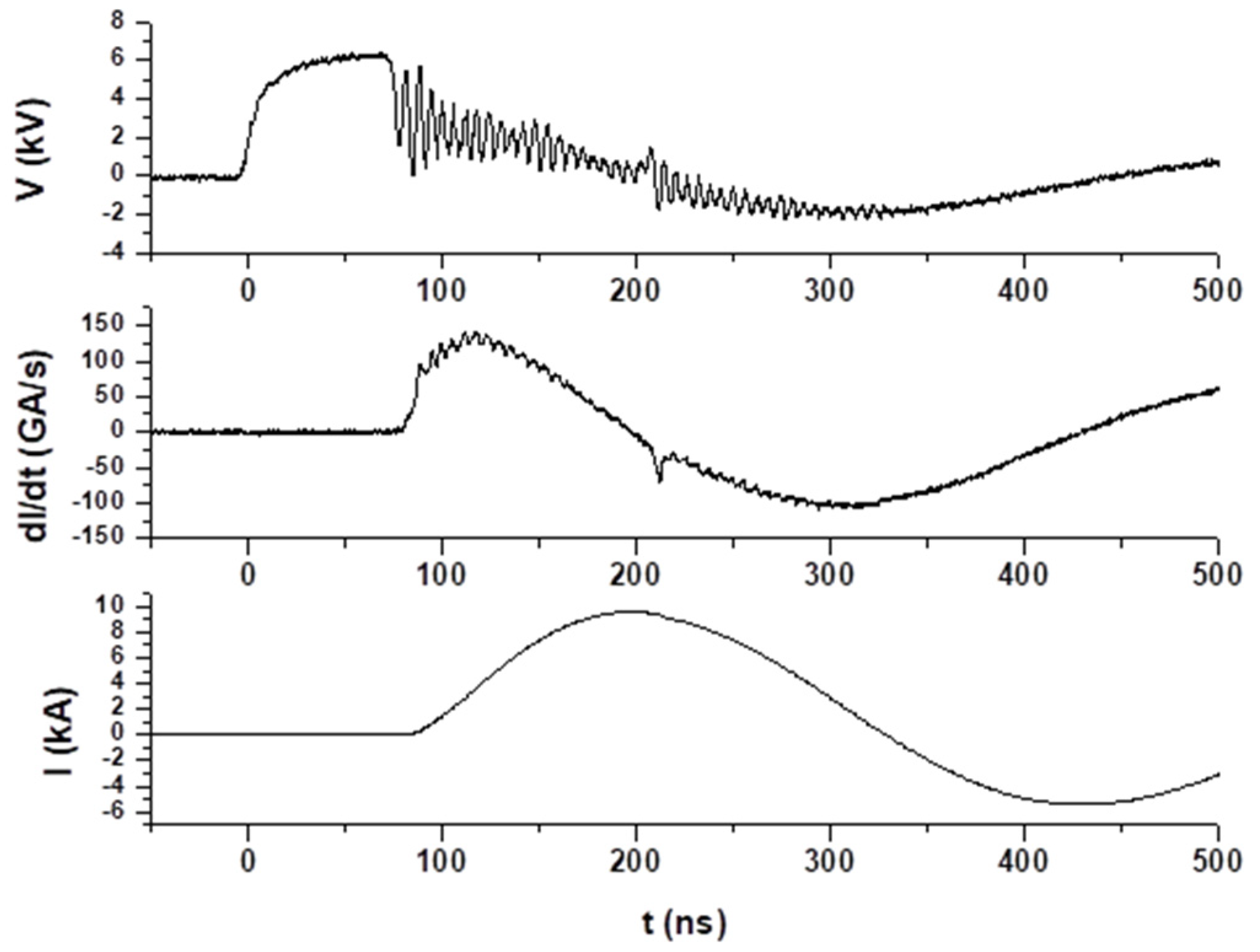Development of a Miniaturized 2-Joule Pulsed Plasma Source Based on Plasma Focus Technology: Applications in Extreme Condition Materials and Nanosatellite Orientation
Abstract
:1. Introduction
2. Materials and Methods
2.1. The Apparatus
2.2. Experimental Characterization
2.2.1. Electrical Diagnostics
2.2.2. Optical Refractive Diagnostics
3. Results
4. Discussion
4.1. Training in Experimental Plasma Physics
4.2. Plasma Deposition of Materials and Nanomaterial Fabrication
4.3. Pulsed Plasma Sources to Study Materials at Extreme Conditions: First Wall of Nuclear Fusion Devices
4.4. Pulsed Plasma Thruster for Nanosatellite Orientation
5. Conclusions
Author Contributions
Funding
Data Availability Statement
Conflicts of Interest
References
- Soto, L.; Pavez, C.; Tarifeno, A.; Moreno, J.; Veloso, F. Studies on scalability and scaling laws for the plasma focus: Similarities and differences in devices from 1 MJ to 0.1 J. Plasma Sources Sci. Technol. 2010, 19, 055017. [Google Scholar] [CrossRef]
- Bernard, A.; Bruzzone, H.; Choi, P.; Chuaqui, H.; Gribkov, V.; Herrera, J.; Hirano, K.; Krejci, K.; Lee, L.; Luo, C.; et al. Scientific status of plasma focus research. J. Mosc. Phys. Soc. 1998, 8, 93–170. [Google Scholar]
- Nukulin, V.Y.; Polukhin, S.N. Saturation of the neutron yield from megajoule plasma focus facilities. Plasma Phys. Rep. 2007, 33, 271–277. [Google Scholar] [CrossRef]
- Lee, S. Neutron yield saturation in plasma focus: A fundamental cause. Appl. Phys. Lett. 2009, 95, 151503. [Google Scholar] [CrossRef]
- Soto, L. New trends and future perspectives on plasma focus research. Plasma Phys. Control. Fusion 2005, 47, A361. [Google Scholar] [CrossRef]
- Krishnan, M. The dense plasma focus: A versatile dense pinch for diverse applications. IEEE Trans. Plasma Sci. 2012, 40, 3189–3221. [Google Scholar] [CrossRef]
- Auluck, S.; Kubes, P.; Paduch, M.; Sadowski, M.J.; Krauz, V.I.; Lee, S.; Soto, L.; Scholz, M.; Miklaszewski, R.; Schmidt, H.; et al. Update on the scientific status of the plasma focus. Plasma 2021, 4, 450–669. [Google Scholar] [CrossRef]
- Soto, L.; Pavez, C.; Moreno, J.; Inestrosa-Izurieta, M.J.; Veloso, F.; Gutiérrez, G.; Vergara, J.; Clausse, A.; Bruzzone, H.; Castillo, F.; et al. Characterization of the axial plasma shock in a table top plasma focus after the pinch and its possible application to testing materials for fusion reactors. Phys. Plasmas 2014, 21, 122703. [Google Scholar] [CrossRef]
- Pavez, C.; Pedreros, J.; Tarifeño-Saldivia, A.; Soto, L. Observation of plasma jets in a table top plasma focus discharge. Phys. Plasmas 2015, 22, 040705. [Google Scholar] [CrossRef]
- Beskin, V.S.; Kalashnikov, I.Y. Internal Structure of the Jets from Young Stars Simulated at Plasma Focus Facilities. Astron. Lett. 2020, 46, 462–472. [Google Scholar] [CrossRef]
- Beskin, V.S. Simulation of the “Central Engine” of Astrophysical Jets within the Plasma Focus Facility. Astron. Rep. 2023, 67, 27–34. [Google Scholar] [CrossRef]
- Krauz, V.I.; Vinogradov, V.P.; Kharrasov, A.M.; Myalton, V.V.; Mitrofanov, K.N.; Beskin, V.S.; Vinogradova, Y.V.; Il’ichev, I.V. Influence of Poloidal Magnetic Field on the Parameters and Dynamics of a Plasma Flow Generated in a Plasma-Focus Discharge in a Laboratory Simulation of Jets from Young Stellar Objects. Astron. Rep. 2023, 67, 15–26. [Google Scholar] [CrossRef]
- Beskin, V.S.; Krauz, V.I.; Lamzin, S.A.E. Laboratory modeling of jets from young stars using plasma focus facilities. Uspekhi Fiz. Nauk 2023, 193, 345–381. [Google Scholar] [CrossRef]
- Soto, L.; Pavez, C.; Castillo, F.; Veloso, F.; Moreno, J.; Auluck, S.K.H. Filamentary structures in dense plasma focus: Current filaments or vortex filaments? Phys. Plasmas 2014, 21, 072702. [Google Scholar] [CrossRef]
- Pavez, C.; Zorondo, M.; Pedreros, J.; Sepúlveda, A.; Soto, L.; Avaria, G.; Moreno, J.; Davis, S.; Bora, B.; Jain, J. New evidence about the nature of plasma filaments in plasma accelerators of type plasma-focus. Plasma Phys. Control. Fusion 2022, 65, 015003. [Google Scholar] [CrossRef]
- Bruzzone, H.; Vieytes, R. The initial phase in plasma focus devices. Plasma Phys. Control. Fusion 1993, 35, 1745. [Google Scholar] [CrossRef]
- Scholz, M.; Ivanova-Stanik, I.M. Initial phase in plasma focus device—Model and computer simulation. Vacuum 2000, 58, 287–293. [Google Scholar] [CrossRef]
- Bruzzone, H. The role of anomalous resistivities in Plasma Focus discharges. Nukleonika 2001, 46, 3–7. [Google Scholar]
- Avaria, G.; Ardila-Rey, J.; Davis, S.; Orellana, L.; Cevallos, B.; Pavez, C.; Soto, L. Hard X-ray emission detection using deep learning analysis of the radiated UHF electromagnetic signal from a plasma focus discharge. IEEE Access 2019, 7, 74899–74908. [Google Scholar] [CrossRef]
- Orellana, L.; Ardila-Rey, J.; Avaria, G.; Diaz, M.A.; Pavez, C.; Schurch, R.; Soto, L. On the relationship between the electromagnetic burst and inductive sensor measurement of a pulsed plasma accelerator. IEEE Access 2019, 7, 133043–133057. [Google Scholar] [CrossRef]
- Rawat, R.S. High-energy-density pinch plasma: A unique nonconventional tool for plasma nanotechnology. IEEE Trans. Plasma Sci. 2013, 41, 701–715. [Google Scholar] [CrossRef]
- Inestrosa-Izurieta, M.J.; Moreno, J.; Davis, S.; Soto, L. Ti film deposition process of a plasma focus: Study by an experimental design. AIP Adv. 2017, 7, 105026. [Google Scholar] [CrossRef]
- Lee, P.; Feng, X.; Zhang, G.X.; Liu, M.H.; Lee, S. Electron lithography using a compact plasma focus. Plasma Sources Sci. Technol. 1997, 6, 343. [Google Scholar] [CrossRef]
- Kato, Y.; Be, S.H. Generation of soft X rays using a rare gas-hydrogen plasma focus and its application to X-ray lithography. Appl. Phys. Lett. 1986, 48, 686–688. [Google Scholar] [CrossRef]
- Bogolyubov, E.P.; Bochkov, V.D.; Veretennikov, V.A.; Vekhoreva, L.T.; Gribkov, V.A.; Dubrovskii, A.V.; Ivanov, Y.P.; Isakov, A.I.; Krokhin, O.N.; Lee, P.; et al. A powerful soft X-ray source for X-ray lithography based on plasma focusing. Phys. Scr. 1998, 57, 488. [Google Scholar] [CrossRef]
- Mangla, O.; Roy, S.; Ostrikov, K. Dense plasma focus-based nanofabrication of III–V semiconductors: Unique features and recent advances. Nanomaterials 2015, 6, 4. [Google Scholar] [CrossRef]
- Rawat, R.S. High energy density pulsed plasmas in plasma focus: Novel plasma processing tool for nanophase hard magnetic material synthesis. Nanosci. Nanotechnol. Lett. 2012, 4, 251–274. [Google Scholar] [CrossRef]
- Inestrosa-Izurieta, M.J.; Ramos-Moore, E.; Soto, L. Morphological and structural effects on tungsten targets produced by fusion plasma pulses from a table top plasma focus. Nucl. Fusion 2015, 55, 093011. [Google Scholar] [CrossRef]
- Linke, J.; Escourbiac, F.; Mazul, I.V.; Nygren, R.; Rödig, M.; Schlosser, J.; Suzuki, S. High heat flux testing of plasma facing materials and components–Status and perspectives for ITER related activities. J. Nucl. Mater. 2007, 367, 1422–1431. [Google Scholar] [CrossRef]
- Davis, S.; González-Cataldo, F.; Gutiérrez, G.; Avaria, G.; Bora, B.; Jain, J.; Moreno, J.; Pavez, C.; Soto, L. A model for defect formation in materials exposed to radiation. Matter Radiat. Extrem. 2021, 6, 015902. [Google Scholar] [CrossRef]
- Pimenov, V.N.; Demina, E.V.; Ivanov, L.I.; Gribkov, V.A.; Dubrovsky, A.V.; Ugaste, U.; Laas, L.; Scholz, M.; Miklaszewski, R.; Kolman, B.; et al. Damage and modification of materials produced by pulsed ion and plasma streams in Dense Plasma Focus device. Nukleonika 2008, 53, 111–121. [Google Scholar]
- Soto, L.; Pavez, C.; Davis, S. Materials Studies for Inertial Fusion Devices Using Pulsed Plasma Shocks from a Repetitive Table Top Plasma Focus Device; No. IAEA-TECDOC-1911; International Atomic Energy Agency: Vienna, Austria, 2020. [Google Scholar]
- Jain, J.; Moreno, J.; Andaur, R.; Armisen, R.; Morales, D.; Marcelain, K.; Avaria, G.; Bora, B.; Davis, S.; Pavez, C.; et al. Hundred joules plasma focus device as a potential pulsed source for in vitro cancer cell irradiation. AIP Adv. 2017, 7, 085121. [Google Scholar] [CrossRef]
- Jain, J.; Araya, H.; Moreno, J.; Davis, S.; Andaur, R.; Bora, B.; Pavez, C.; Marcelain, K.; Soto, L. Hyper-radiosensitivity in tumor cells following exposure to low dose pulsed X-rays emitted from a kilojoule plasma focus device. J. Appl. Phys. 2021, 130, 164902. [Google Scholar] [CrossRef]
- Verdejo, V.; Radl, A.; Barquinero, J.F.; Jain, J.; Davis, S.; Pavez, C.; Soto, L.; Moreno, J. Use of a plasma focus device to study pulsed X-ray effects on peripheral blood lymphocytes: Analysis of chromosome aberrations. J. Appl. Phys. 2023, 133, 163302. [Google Scholar] [CrossRef]
- Gribkov, V.A.; Orlova, M.A. On various possibilities in pulsed radiation biochemistry and chemistry. Radiat. Environ. Biophys. 2004, 43, 303–309. [Google Scholar] [CrossRef]
- Isolan, L.; Laghi, D.; Zironi, I.; Cremonesi, M.; Garibaldi, C.; Buontempo, F.; Sumini, M. Compact and very high dose-rate plasma focus radiation sources for medical applications. Radiat. Phys. Chem. 2022, 200, 110296. [Google Scholar] [CrossRef]
- Virelli, A.; Zironi, I.; Pasi, F.; Ceccolini, E.; Nano, R.; Facoetti, A.; Gavoçi, E.; Fiore, M.R.; Rocchi, F.; Mostacci, D.; et al. Early effects comparison of X rays delivered at high-dose-rate pulses by a plasma focus device and at low dose rate on human tumour cells. Radiat. Prot. Dosim. 2015, 166, 383–387. [Google Scholar] [CrossRef]
- Temple, B.; Barnouin, O.; Miley, G.H. Plasma focus device for use in space propulsion. Fusion Technol. 1991, 19, 846–851. [Google Scholar] [CrossRef]
- Soto, L.; Pedreros, J.; Silva, R.; Maldonado, P.; Avaria, G.; Pavez, C.; Moreno, J.; Diaz, M. Pulsed Plasma Thruster Based on Ultra-miniaturized Plasma Focus. In Proceedings of the 19th International Congress on Plasma Physics (ICPP), Vancouver, BC, Canada, 4–8 June 2018. [Google Scholar]
- Soto, L.; Pavez, C.; Moreno, J.; Jain, J.; Aubel, K.; Díaz, M.; Pedreros, J.; Silva, R.; Tello. Ultra-miniaturized Pulsed Plasma Thruster for Nanosatellites. In Proceedings of the 23rd IEEE Pulsed Power Conference (PPC) and the 29th IEEE Symposium on Fusion Engineering E), Denver, CO, USA, 12–16 December 2021. [Google Scholar]
- Soto, L.; Pavéz, C.; Moreno, J.; Tarifeño, A.; Pedreros, J.; Altamirano, L. Nanofocus of tenth of joules and a portable plasma focus of few joules for field applications. In AIP Conference Proceedings; American Institute of Physics: Melville, NY, USA, 2009; Volume 1088, pp. 219–222. [Google Scholar]
- Soto, L.; Pavez, C.; Moreno, J.; Pedreros, J.; Altamirano, L. Non-radioactive source for field applications based in a plasma focus of 2J: Pinch evidence. J. Phys. Conf. Ser. 2014, 511, 012032. [Google Scholar] [CrossRef]
- Moreno, C.; Vénere, M.; Barbuzza, R.; Del Fresno, M.; Ramos, R.; Bruzzone, H.; González, F.P.J.; Clausse, A. Industrial applications of plasma focus radiation. Braz. J. Phys. 2002, 32, 20–25. [Google Scholar] [CrossRef]
- Raspa, V.; Di Lorenzo, F.; Knoblauch, P.; Lazarte, A.; Tartaglione, A.; Clausse, A.; Moreno, C. Plasma focus based repetitive source of fusion neutrons and hard X-rays. PMC Phys. A 2008, 2, 1–15. [Google Scholar] [CrossRef]
- Silva, P.; Moreno, J.; Soto, L.; Birstein, L.; Mayer, R.E.; Kies, W. Neutron emission from a fast plasma focus of 400 joules. Appl. Phys. Lett. 2003, 83, 3269–3271. [Google Scholar] [CrossRef]
- Milanese, M.; Moroso, R.; Pouzo, J. DD neutron yield in the 125 J dense plasma focus nanofocus. Eur. Phys. J. D At. Mol. Opt. Plasma Phys. 2003, 27, 77–81. [Google Scholar]
- Silva, P.; Soto, L.; Moreno, J.; Sylvester, G.; Zambra, M.; Altamirano, L.; Bruzzone, H.; Clausse, A.; Moreno, C. A plasma focus driven by a capacitor bank of tens of joules. Rev. Sci. Instrum. 2002, 73, 2583–2587. [Google Scholar] [CrossRef]
- Verma, R.; Rawat, R.S.; Lee, P.; Krishnan, M.; Springham, S.V.; Tan, T.L. Experimental study of neutron emission characteristics in a compact sub-kilojoule range miniature plasma focus device. Plasma Phys. Control. Fusion 2009, 51, 075008. [Google Scholar] [CrossRef]
- Pavez, C.; Pedreros, J.; Zambra, M.; Veloso, F.; Moreno, J.; Ariel, T.S.; Soto, L. Potentiality of a small and fast dense plasma focus as hard X-ray source for radiographic applications. Plasma Phys. Control. Fusion 2012, 54, 105018. [Google Scholar] [CrossRef]
- Ellsworth, J.L.; Falabella, S.; Tang, V.; Schmidt, A.; Guethlein, G.; Hawkins, S.; Rusnak, B. Design and initial results from a kilojoule level dense plasma focus with hollow anode and cylindrically symmetric gas puff. Rev. Sci. Instrum. 2014, 85, 013504. [Google Scholar] [CrossRef]
- Barbaglia, M.; Bruzzone, H.; Acuña, H.; Soto, L.; Clausse, A. Experimental study of the hard X-ray emissions in a plasma focus of hundreds of Joules. Plasma Phys. Control. Fusion 2009, 51, 045001. [Google Scholar] [CrossRef]
- Silva, P.; Soto, L.; Kies, W.; Moreno, J. Pinch evidence in a fast and small plasma focus of only tens of joules. Plasma Sources Sci. Technol. 2004, 13, 329. [Google Scholar] [CrossRef]
- Mohanty, S.R.; Sakamoto, T.; Kobayashi, Y.; Song, I.; Watanabe, M.; Kawamura, T.; Okino, A.; Horioka, K.; Hotta, E. Miniature hybrid plasma focus extreme ultraviolet source driven by 10 kA fast current pulse. Rev. Sci. Instrum. 2006, 77, 043506. [Google Scholar] [CrossRef]
- Soto, L.; Silva, P.; Moreno, J.; Zambra, M.; Kies, W.; Mayer, R.E.; Clausse, A.; Altamirano, L.; Pavez, C.; Huerta, L. Demonstration of neutron production in a table-top pinch plasma focus device operating at only tens of joules. J. Phys. D Appl. Phys. 2008, 41, 205215. [Google Scholar] [CrossRef]
- Verma, R.; Rawat, R.S.; Lee, P.; Krishnan, M.; Springham, S.V.; Tan, T.L. Miniature plasma focus device as a compact hard X-ray source for fast radiography applications. IEEE Trans. Plasma Sci. 2010, 38, 652–657. [Google Scholar] [CrossRef]
- Shukla, R.; Sharma, S.K.; Banerjee, P.; Das, R.; Deb, P.; Prabahar, T.; Das, B.K.; Adhikary, B.; Shyam, A. Low voltage operation of plasma focus. Rev. Sci. Instrum. 2010, 81, 083501. [Google Scholar] [CrossRef]
- Bures, B.L.; Krishnan, M.; James, C. A plasma focus electronic neutron generator. IEEE Trans. Plasma Sci. 2012, 40, 1082–1088. [Google Scholar] [CrossRef]
- Tarifeno-Saldivia, A.; Soto, L. Statistical characterization of the reproducibility of neutron emission of small plasma focus devices. Phys. Plasmas 2012, 19, 092512. [Google Scholar] [CrossRef]
- Rout, R.K.; Niranjan, R.; Mishra, P.; Srivastava, R.; Rawool, A.M.; Kaushik, T.C.; Gupta, S.C. Palm top plasma focus device as a portable pulsed neutron source. Rev. Sci. Instrum. 2013, 84, 063503. [Google Scholar] [CrossRef] [PubMed]
- Tarifeño-Saldivia, A.; Pavez, C.; Moreno, J.; Soto, L. Dynamics and density measurements in a small plasma focus of tens-of-joules-emitting neutrons. IEEE Trans. Plasma Sci. 2010, 39, 756–760. [Google Scholar] [CrossRef]
- Goudarzi, S.; Babaee, H. Results of the preliminary experiments with a miniaturized plasma focus device. Plasma Phys. Rep. 2020, 46, 97–101. [Google Scholar] [CrossRef]
- Soto, L.; Pavez, C.; Moreno, J.; Barbaglia, M.; Clausse, A. Nanofocus: An ultra-miniature dense pinch plasma focus device with submillimetric anode operating at 0.1 J. Plasma Sources Sci. Technol. 2008, 18, 015007. [Google Scholar] [CrossRef]
- Pavez, C.; Soto, L. Demonstration of X-ray emission from an ultraminiature pinch plasma focus discharge operating at 0.1 J nanofocus. IEEE Trans. Plasma Sci. 2010, 38, 1132–1135. [Google Scholar] [CrossRef]
- Barbaglia, M.O.; Bruzzone, H.; Acuña, H.N.; Soto, L.; Clausse, A. Electrical behavior of an ultralow-energy plasma-focus device. IEEE Trans. Plasma Sci. 2014, 42, 138–142. [Google Scholar] [CrossRef]
- Soto, L.; Pavez, C.; Moreno, J.; Altamirano, L.; Huerta, L.; Barbaglia, M.; Clausse, A.; Mayer, R.E. Evidence of nuclear fusion neutrons in an extremely small plasma focus device operating at 0.1 Joules. Phys. Plasmas 2017, 24, 082703. [Google Scholar] [CrossRef]
- Veloso, F.; Pavez, C.; Moreno, J.; Galaz, V.; Zambra, M.; Soto, L. Correlations among neutron yield and dynamical discharge characteristics obtained from electrical signals in a 400 J plasma focus. J. Fusion Energy 2012, 31, 30–37. [Google Scholar] [CrossRef]
- Veloso, F.; Tarifeno-Saldivia, A.; Pavez, C.; Moreno, J.; Zambra, M.; Soto, L. Plasma sheath kinematics and some implications on the modeling of very low energy plasma focus devices. Plasma Phys. Control. Fusion 2012, 54, 095007. [Google Scholar] [CrossRef]
- Bruzzone, H.; Acuña, H.; Barbaglia, M.; Clausse, A. A simple plasma diagnostic based on processing the electrical signals from coaxial discharges. Plasma Phys. Control. Fusion 2006, 48, 609. [Google Scholar] [CrossRef]
- Hutchinson, I. Principles of Plasma Diagnostics; Cambridge University Press: Cambridge, MA, USA, 2002. [Google Scholar]
- Rogowski, W.; Steinhaus, W. Die messung der magnetischen spannung. Electr. Eng. (Arch. Elektrotechnik) 1912, 1, 141–150. [Google Scholar] [CrossRef]
- Pellinen, D.G.; Di Capua, M.S.; Sampayan, S.E.; Gerbracht, H.; Wang, M. Rogowski coil for measuring fast, high-level pulsed currents. Rev. Sci. Instrum. 1980, 51, 1535–1540. [Google Scholar] [CrossRef]
- Ostrovsky, Y.I.; Butusov, M.M.; Ostrovskaya, G.V. Interferometry by Holography; Springer: New York, NY, USA, 1980. [Google Scholar]
- Lee, S.; Serban, A. Dimensions and lifetime of the plasma focus pinch. IEEE Trans. Plasma Sci. 1996, 24, 1101–1105. [Google Scholar]
- Zanelli, D.; López, E.; Pavez, C.; Pedreros, J.; Jain, J.; Avaria, G.; Moreno, J.; Bora, B.; Davis, S.; Soto, L. Analysis of deterioration in a plasma focus device. J. Phys. Conf. Ser. 2018, 1043, 012049. [Google Scholar] [CrossRef]
- Soto, L.; Zanelli, D.; Jain, J.; Pavez, C.; Moreno, J.; Bora, B.; Davis, S. A Repetitive Tabletop Pulsed Plasma Device to Study Materials Under Intense Fusion Relevant Pulses, 2021, 28th IAEA-FEC 2020. Available online: https://conferences.iaea.org/event/214/contributions/17648/ (accessed on 18 September 2022).
- Soto, L. How to Build a Small Plasma Focus. Recipes and Tricks. 2012. Available online: https://indico.ictp.it/event/a11188/session/8/contribution/5/material/0/0.pdf (accessed on 18 September 2022).
- Soto, L. A Self Scale Z-Pinch. Scalability, Similarities and Differences in Plasma Focus Devices: Basic Research and Applications. 2018. Available online: https://indico.ictp.it/event/8335/session/20/contribution/87/material/slides/0.pdf (accessed on 18 September 2022).
- Garkusha, I.E.; Bandura, A.N.; Byrka, O.V.; Chebotarev, V.V.; Landman, I.; Makhlaj, V.A.; Pestchanyi, S.; Tereshin, V.I. Damage to preheated tungsten targets after multiple plasma impacts simulating ITER ELMs. J. Nucl. Mater. 2009, 386, 127–131. [Google Scholar] [CrossRef]
- Gonzalez-Arrabal, R.; Rivera, A.; Perlado, J.M. Limitations for tungsten as plasma facing material in the diverse scenarios of the European inertial confinement fusion facility HiPER: Current status and new approaches. Matter Radiat. Extrem. 2020, 5, 055201. [Google Scholar] [CrossRef]
- Tummala, A.; Dutta, A. An Overview of Cube-Satellite Propulsion Technologies and Trends. Aerospace 2017, 4, 58. [Google Scholar] [CrossRef]
- Pagan, A.S.; Fugmann, M.; Herdrich, G. A System Approach towards a miniaturized Pulsed Plasma Thruster for a CubeSat-Type Deorbit Module. In Proceedings of the 5th Russian German Conference on Electric Propulsion and Their Application, Dresden, Germany, 7–12 September 2014; p. 11. [Google Scholar]
- Jahn, R.G. Physics of Electric Propulsion; McGraw-Hill: New York, NY, USA, 1969. [Google Scholar]
- Decker, G.; Kies, W.; Pross, G. The first and the final fifty nanoseconds of a fast focus discharge. Phys. Fluids 1983, 26, 571. [Google Scholar] [CrossRef]










| C (nF) | L (nH) | V (kV) | I (kA) | E (J) |
|---|---|---|---|---|
| 120 | 40 | 6–9 | 10.4–15.6 | 2.16–4.86 |
Disclaimer/Publisher’s Note: The statements, opinions and data contained in all publications are solely those of the individual author(s) and contributor(s) and not of MDPI and/or the editor(s). MDPI and/or the editor(s) disclaim responsibility for any injury to people or property resulting from any ideas, methods, instructions or products referred to in the content. |
© 2024 by the authors. Licensee MDPI, Basel, Switzerland. This article is an open access article distributed under the terms and conditions of the Creative Commons Attribution (CC BY) license (https://creativecommons.org/licenses/by/4.0/).
Share and Cite
Soto, L.; Pavez, C.; Pedreros, J.; Jain, J.; Moreno, J.; San Martín, P.; Castillo, F.; Zanelli, D.; Altamirano, L. Development of a Miniaturized 2-Joule Pulsed Plasma Source Based on Plasma Focus Technology: Applications in Extreme Condition Materials and Nanosatellite Orientation. Micromachines 2024, 15, 1123. https://doi.org/10.3390/mi15091123
Soto L, Pavez C, Pedreros J, Jain J, Moreno J, San Martín P, Castillo F, Zanelli D, Altamirano L. Development of a Miniaturized 2-Joule Pulsed Plasma Source Based on Plasma Focus Technology: Applications in Extreme Condition Materials and Nanosatellite Orientation. Micromachines. 2024; 15(9):1123. https://doi.org/10.3390/mi15091123
Chicago/Turabian StyleSoto, Leopoldo, Cristian Pavez, José Pedreros, Jalaj Jain, José Moreno, Patricio San Martín, Fermín Castillo, Daniel Zanelli, and Luis Altamirano. 2024. "Development of a Miniaturized 2-Joule Pulsed Plasma Source Based on Plasma Focus Technology: Applications in Extreme Condition Materials and Nanosatellite Orientation" Micromachines 15, no. 9: 1123. https://doi.org/10.3390/mi15091123






